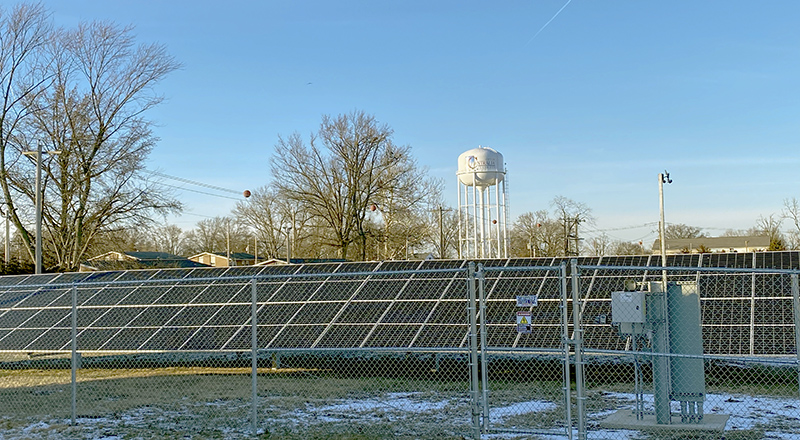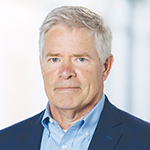
The most recent example of SSM Health's commitment to environmental sustainability can be found in a field in Centralia, Illinois. The field contains an array of solar panels, which will supply energy to SSM Health St. Mary's Hospital.

The collection of solar panels went online in November and is the first of several that SSM Health envisions in the four states it serves. The system plans to bring an array online at SSM Health Good Samaritan Hospital in Mount Vernon, Illinois, this year.
The solar projects are one facet of SSM's commitment to the White House's climate pledge for health care organizations to become carbon-neutral by 2050. Other projects focused on environmental sustainability include reducing the use of plastic water bottles, diverting hundreds of tons of surgical waste from landfills, and investing in solar energy financing funds and water infrastructure funds that are focused on environmental sustainability.
To learn more about the solar projects and SSM's plans to fulfill the climate pledge, Catholic Health World talked to Gerry Kaiser, SSM Health's vice president of facilities and real estate.
Why take the health care pledge to be carbon neutral by 2050?
We wanted to show our commitment to joining others in addressing the carbon footprint issue. It helps bring awareness both in and outside the system as we're tracking and looking at our progress in reducing our footprint. And, reducing our carbon footprint and the impact on the environment aligns with the mission and values of SSM. It's part of who we are.
Why are solar arrays part of the first phase of your strategy?
Solar arrays help reduce Scope 2 emissions, which is energy you purchase. The primary purchases for most systems are natural gas and electricity. We also have to look at how that electricity is produced: Is it produced by nuclear energy, coal fire, natural gas? So, we can reduce emissions if we can get as much energy as possible from clean sources, like solar.
Why start the initiative in Illinois?
Of the four states we operate in, Illinois is most favorable for solar because of incentives. So it was a natural place to start.
How much of the electricity that the hospital uses does the solar array provide?
It's about 20%. We try to size it for what we call the baseload for what the hospital needs. The load varies day to day and season to season. You're limited based on how much ground you've got, but we have a second phase at Centralia that we're looking at. We've got some more land that we could put to use.
Can you provide an update on the array at SSM Health Good Samaritan Hospital in Mount Vernon?
We have materials on-site for the first phase at Mount Vernon. Construction was scheduled to start in March, and we expect Mount Vernon to be online later this year, probably in the fall.
What is the strategy and timetable in your other states: Missouri, Oklahoma and Wisconsin?
In Missouri, the electric utility, Ameren, is developing solar arrays themselves. Ameren approached a number of larger users and asked them to subscribe to the solar farm they are building. We've subscribed to their first phase farm, which is expected to go online in 2025, and is expected to pick up 17% of our usage in the St. Louis area. They also are planning a phase two. We'll subscribe and take more power from them.
One of the other things we're exploring is participating in the Inflation Reduction Act, which allows nonprofits to receive direct payments in lieu of tax credits for renewable energy. We're in the development process of projects in Oklahoma and Wisconsin that we hope to have reimbursed by IRA.
Taken as a group, how much could solar energy eventually reduce the system's carbon footprint?
Under current technology, we'd hope to get 40% to 50%. If Ameren keeps building, we'll keep buying. There are other opportunities that could be on the table, such as community-produced solar. At this point, I'd say 10 years is a good time frame for reaching that goal.
Can you give details on other projects that can help meet the goal of being carbon-neutral by 2050?
We've adopted guidelines to design new facilities to meet WELL building certification, in lieu of LEED (Leadership in Energy and Environmental Design). The standards are similar, but WELL building emphasizes ongoing operation and the interior design, and how they affect people working inside the building, more than how you build it, which LEED does. As we design new projects, we're looking to incorporate ways to convert out of fossil fuel consumption to electric, in the belief that we can get more clean electric power in the future.
We've been involved in a number of tree planting efforts over the years. CEO Laura Kaiser asked that we plant thousands of trees across our system over the last few years. And we're involved in a community effort called Forest ReLeaf to plant trees in St. Louis. We're looking for similar organizations in the other regions.
What are the pie-in-the-sky goals or benchmarks along the way that you want to hit every 10 or 15 years?
We brought on Adam Walker as a sustainability manager for the system last year. He's working to establish the strategy: what we want to achieve, when we want to achieve it and most importantly, how we're going to achieve it.
